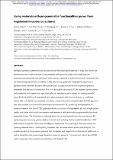| dc.contributor.author | Gilbert, Charlie | |
| dc.contributor.author | Tang, Tzu-Chieh | |
| dc.contributor.author | Ott, Wolfgang | |
| dc.contributor.author | Dorr, Brandon A | |
| dc.contributor.author | Shaw, William M | |
| dc.contributor.author | Sun, George L | |
| dc.contributor.author | Lu, Timothy K | |
| dc.contributor.author | Ellis, Tom | |
| dc.date.accessioned | 2021-10-27T19:58:28Z | |
| dc.date.available | 2021-10-27T19:58:28Z | |
| dc.date.issued | 2021 | |
| dc.identifier.uri | https://hdl.handle.net/1721.1/134171 | |
| dc.description.abstract | © 2021, The Author(s), under exclusive licence to Springer Nature Limited. Biological systems assemble living materials that are autonomously patterned, can self-repair and can sense and respond to their environment. The field of engineered living materials aims to create novel materials with properties similar to those of natural biomaterials using genetically engineered organisms. Here, we describe an approach to fabricating functional bacterial cellulose-based living materials using a stable co-culture of Saccharomyces cerevisiae yeast and bacterial cellulose-producing Komagataeibacter rhaeticus bacteria. Yeast strains can be engineered to secrete enzymes into bacterial cellulose, generating autonomously grown catalytic materials and enabling DNA-encoded modification of bacterial cellulose bulk properties. Alternatively, engineered yeast can be incorporated within the growing cellulose matrix, creating living materials that can sense and respond to chemical and optical stimuli. This symbiotic culture of bacteria and yeast is a flexible platform for the production of bacterial cellulose-based engineered living materials with potential applications in biosensing and biocatalysis. | |
| dc.language.iso | en | |
| dc.publisher | Springer Science and Business Media LLC | |
| dc.relation.isversionof | 10.1038/s41563-020-00857-5 | |
| dc.rights | Article is made available in accordance with the publisher's policy and may be subject to US copyright law. Please refer to the publisher's site for terms of use. | |
| dc.source | bioRxiv | |
| dc.title | Living materials with programmable functionalities grown from engineered microbial co-cultures | |
| dc.type | Article | |
| dc.contributor.department | Massachusetts Institute of Technology. Synthetic Biology Center | |
| dc.contributor.department | Massachusetts Institute of Technology. Media Laboratory | |
| dc.contributor.department | Massachusetts Institute of Technology. Department of Biological Engineering | |
| dc.contributor.department | Koch Institute for Integrative Cancer Research at MIT | |
| dc.contributor.department | Massachusetts Institute of Technology. Department of Electrical Engineering and Computer Science | |
| dc.relation.journal | Nature Materials | |
| dc.eprint.version | Original manuscript | |
| dc.type.uri | http://purl.org/eprint/type/JournalArticle | |
| eprint.status | http://purl.org/eprint/status/NonPeerReviewed | |
| dc.date.updated | 2021-01-28T19:50:26Z | |
| dspace.orderedauthors | Gilbert, C; Tang, T-C; Ott, W; Dorr, BA; Shaw, WM; Sun, GL; Lu, TK; Ellis, T | |
| dspace.date.submission | 2021-01-28T19:50:31Z | |
| mit.journal.volume | 20 | |
| mit.journal.issue | 5 | |
| mit.license | PUBLISHER_POLICY | |
| mit.metadata.status | Authority Work and Publication Information Needed | |
